In my mind, there are three schools of thought when it comes to Essen-Saturday: those that love the buzz of the busiest day of the fair, those that had to do it because they could not go earlier due to work, and those that give up and just stay home. I’m in the latter camp. 😀 I’ve learned a long time ago that I happily invest vacation days to avoid weekends at Essen. Also Saturday is a great day to recuperate from all the shouting over noise, running around, and general stress/exhilaration of the two previous convention days and simply start playing your own purchases instead of patiently waiting for seats at tables to get free.
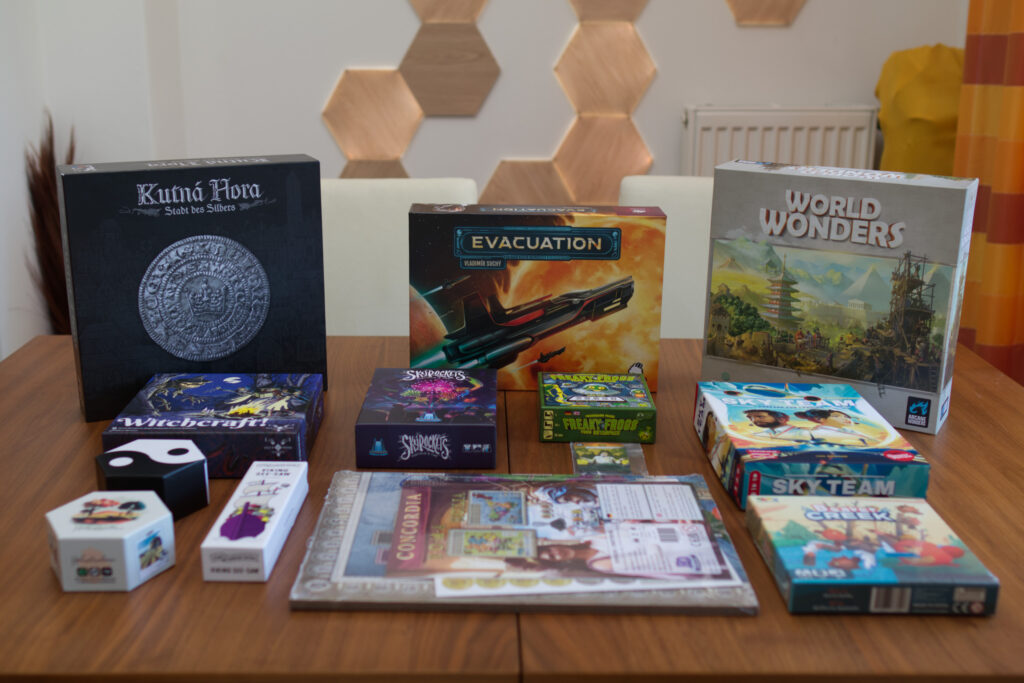
So my third day of Essen started in the comfort of my home with a good cup of tea and some unboxing. First off, I wanted to give Hextremadura by LittleHouse Boardgames a shot. As I wrote yesterday, the rules explanations at the publisher’s booth had been shaky due to a slight language barrier issue and with Hextremadura, I just gave up and bought the game unplayed. Today would show if my gut feeling was right or if I had bought a dud.
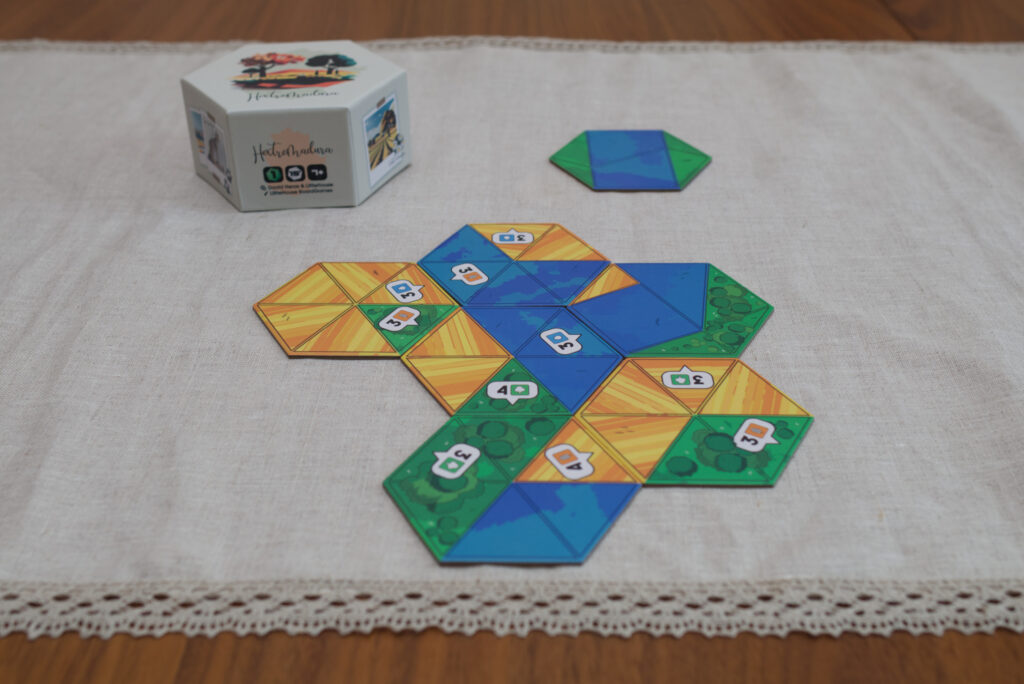
In Hextremadura, the single solo player tries to place 18 large hex-shaped tiles into an evolving landscape to fulfil tasks. What at first might look like someone had seen Dorfromantik: The Board Game and said “hold my beer, I can do that!” quickly turns into a sneaky puzzler. Within placing the first 2-3 tiles, a broad smile developed on my face and I got slight AP – which in a solo game is actually a good thing! What makes this game smarter than it looks is that it works in two phases. First all tiles are placed using the top side which shows triangles of three types of landscapes (fields, forest, lakes) and two simple tasks per tile (e.g. “place this pointing to a 4 space forest). Once both tasks are completed, the tile is removed and set aside. Here comes the first challenge: with everything you complete, you’re ripping apart the things you set up to fulfil the next tile. So order becomes very important.
The second phase of the game starts once you’ve run through the draw pile. Flip over the stack of completed tiles that were set aside before and now use those to again place into the landscape. The back-sides no longer contain the simple tasks but one or more icons (acorns, storks, ruins) and now a global condition (e.g. somewhere in the landscape there needs to be a forest with a stork next to a water with a ruin). And these global conditions are what actually provides VP at the end! So not only do you not know what conditions you will be scoring for until you flip the stack, you also can use those tiles to complete yet incomplete front-side tiles on the table and prolong the game. But that then again rips stuff apart which you might need to stay connected for the global scoring. It’s clever, the production is lovely, and it’s only 15€! If you like solo puzzlers, you should pick one up.
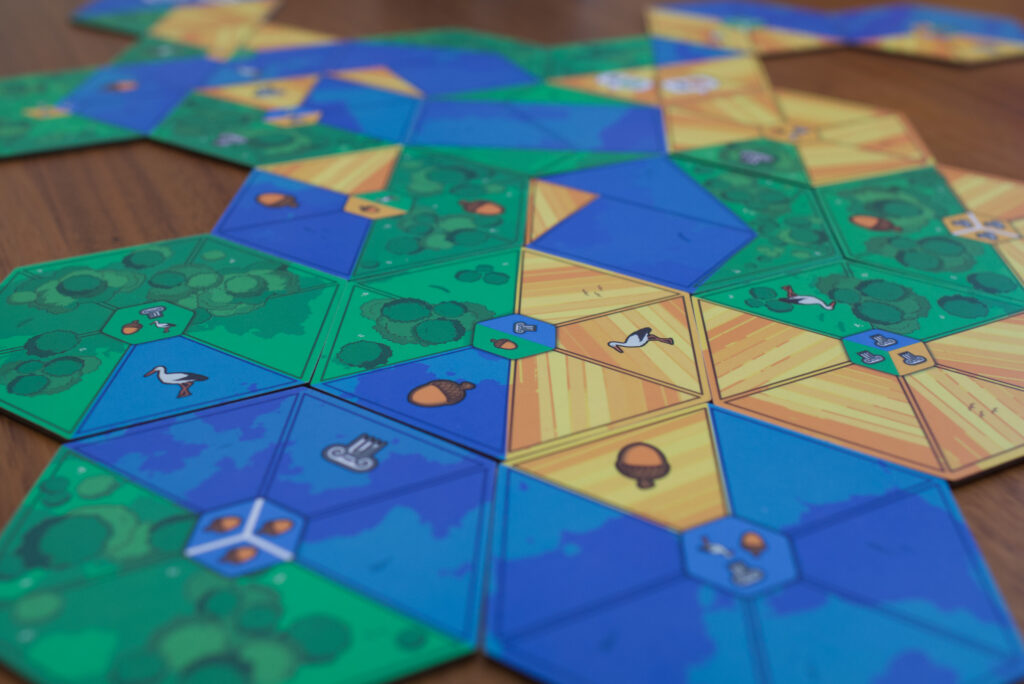
Next was Friedemann Friese’s Freaky Frogs From Outaspace, a solo pinball game. Friedemann is always good for innovative, somewhat “out there” ideas that no one has done before, and he again doesn’t disappoint. What makes this game special is that the included pinball table (a folded mini-poster) actually just acts as a mental map and if you play the game often, you won’t be needing it at all.
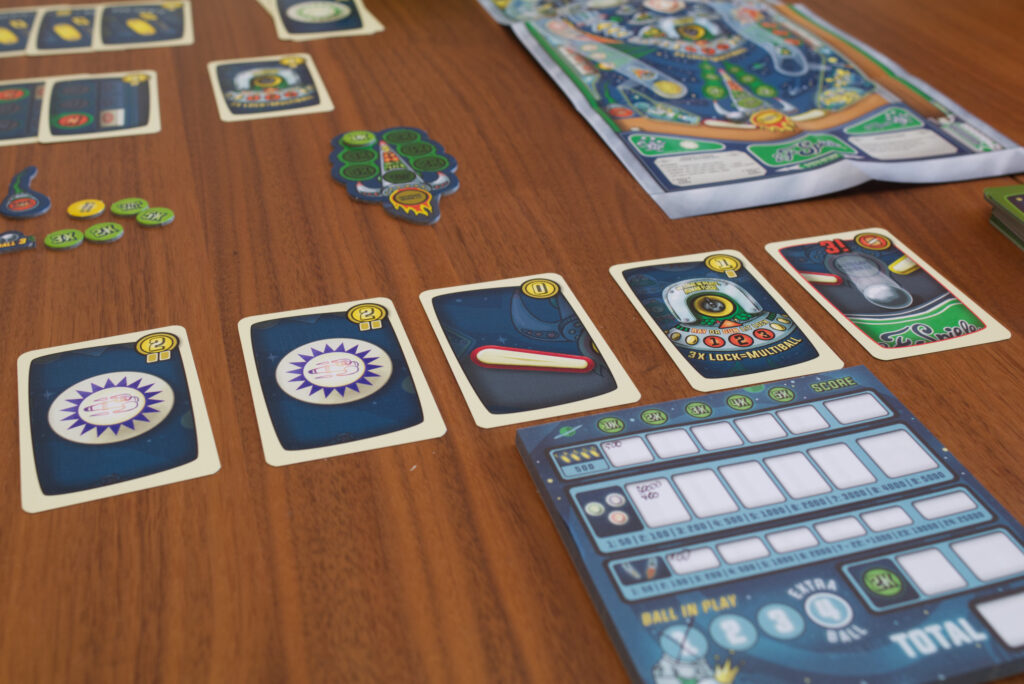
The heart of the game are the action cards that depend on each other based on the physical adjacency of the elements on the pinball table. For example: when the ball enters the table, it of course starts at the top and hits the top most element (a collection of letters that need to be completed). If you have a card that belongs to it, you can play it, if not, the ball just continues to drop downwards to the next thing beneath it. If you hit the bumpers, you can either continue to play bumper cards (the ball bounces between them) or shoot off to a number of other elements. Rails require starting at a pedal and ending at the same pedal, and so on. In essence it’s all about managing your card hand to have the right card in it to perform a bigger combo. If the ball comes over a rail towards the left pedal and you don’t have a left pedal card, you lose a life, and so on. You draw new cards depending on how much speed your ball has but the higher the speed, the higher the risk. We’ll have to see how much fun it is on repeated plays, but it’s a super clever piece of design and again a nice, cheap, small box game.
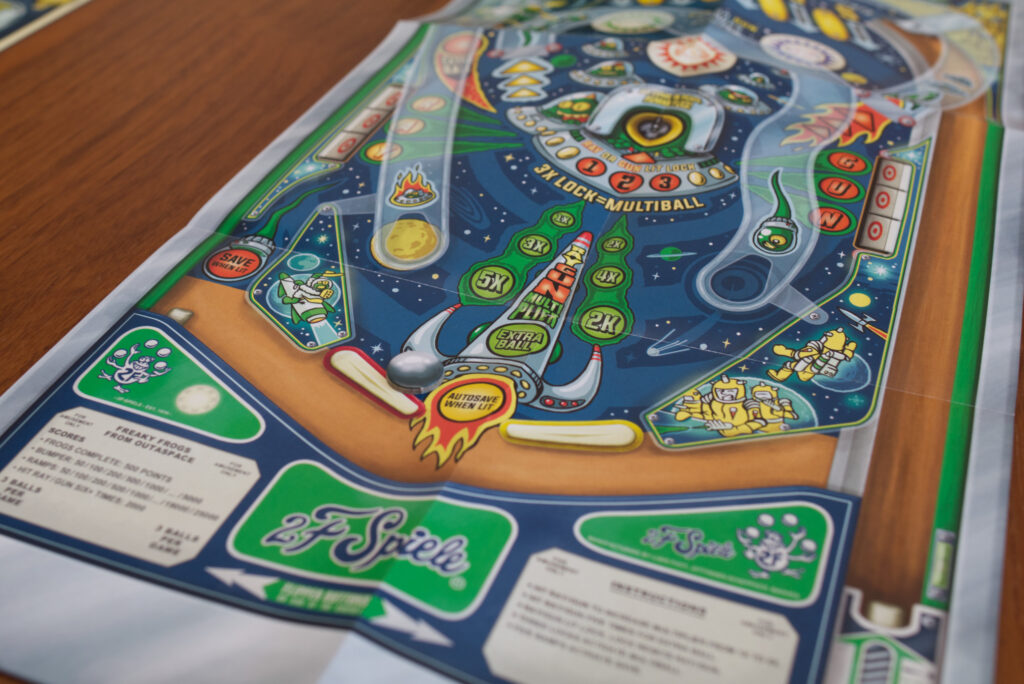
Note: as a lot of 2F games, this one also comes with its own slight quirks and there are some smaller usability improvements that could have been made. For example, it would have been helpful to have an arrow on the ball so you remember if it is currently going up or down (which changes which cards you are allowed to play) and the explanation which element is reachable from where is only in the rules, not on the poster nor on the cards. However, it’s all quite logical and after a few rounds, it’s becoming second nature. One nice touch is that the pinball poster has a backside that fades out all the fluff and makes it way easier to orientate yourself in your first plays. Another thing I want to highlight is: there is no plastic in this box! The cards are wrapped in paper and the only plastic waste is the wrapping around the box. More games should do this, it’s awesome.
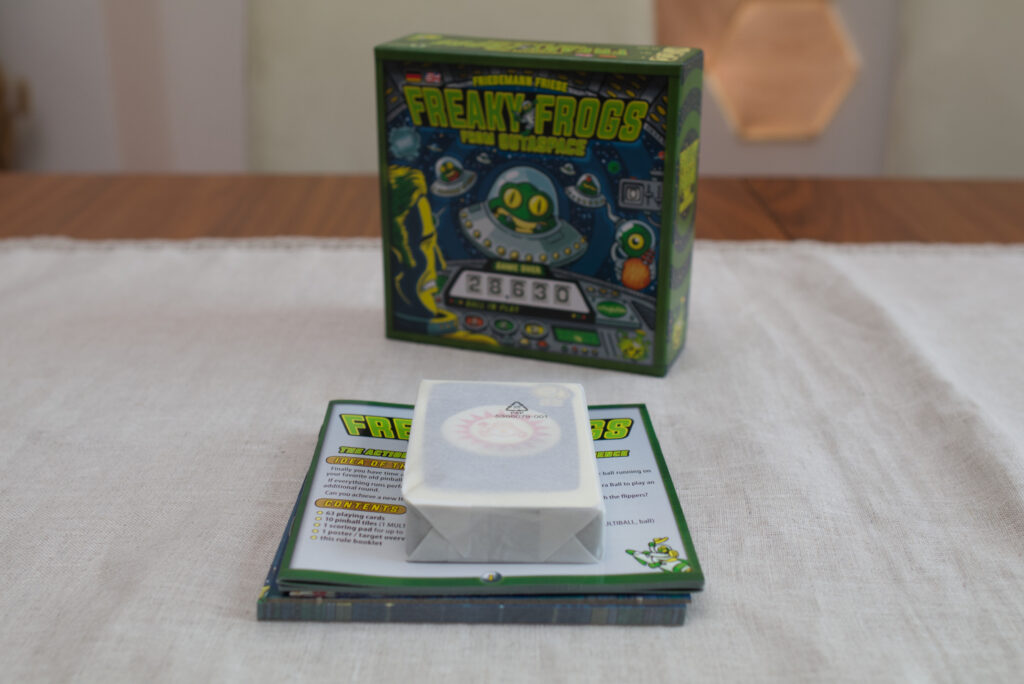
I spent the afternoon drinking a lot of tea (it really is quite loud in those halls so you’re constantly stressing your voice) and catching up with what the YouTube world had posted about Essen. If you haven’t been at Essen, you’ll probably underestimate how taxing a day at the fair can be. Each day, it’s 11 hours (10 on Sunday) of walking around, noise, crowds, hauling games, usually non-healthy snacks, etc.
It’s always fun to see the things I’ve missed. Essen is so huge, there can be crazes you completely miss or people around you never see! Overall, I’m quite happy with the games I purchased / demoed and everything else I’m content to try at a later time. In the end, most things sold at Essen find their way into the retail/online market sooner or later anyway and despite what most people think, most new games at Essen are actually at MSRP and can be found cheaper online later on. Also, there is only so much one person can play. Even with my modest haul, combined with the inflow of games before Essen (Roads & Boats, Voidfall, Votes for Women, Fit to Print, …), I’ve got a lot to cover in the next weeks/months. If you’re interested in hearing more about those games and the ones I got at Essen, you might want to keep an eye on my regular format: Talking Shelf Space – In-Depth First Impressions and Reviews
The main course of the day was playing a 4p game of Kutná Hora: The City of Silver. It had been a tough choice between Kutná Hora and Evacuationbut I still haven’t caught up on sleep and the former seemed to be the more relaxing choice, knowing Vladimir Sutchy’s other games 😀
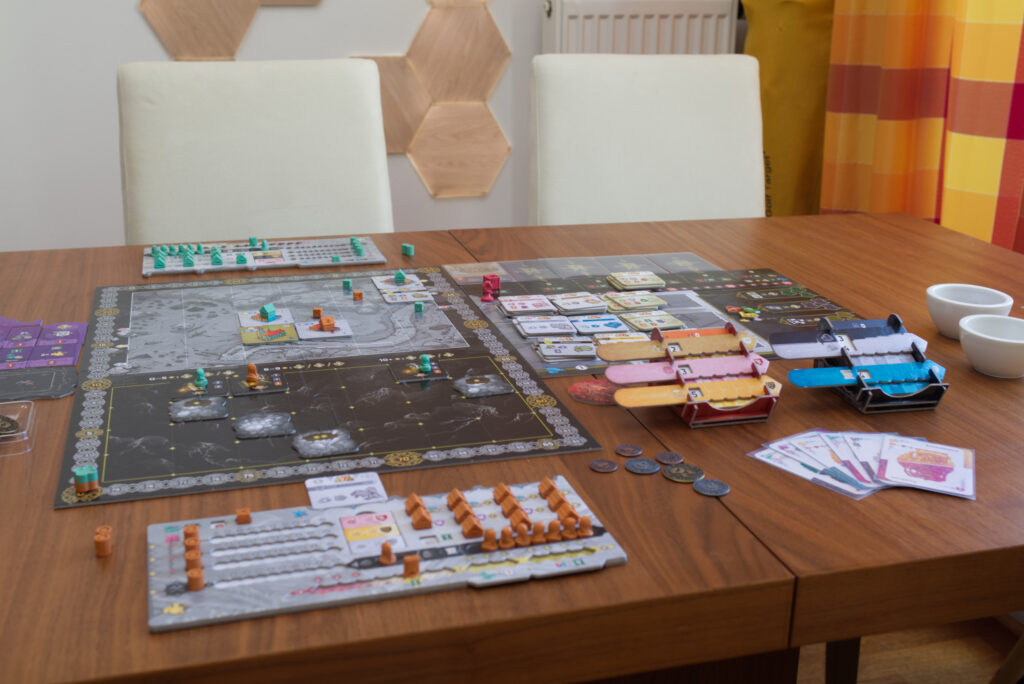
In Kutná Hora, players construct buildings in the town or extend the nearby mines. The clue of the game are the “computers”, cardboard constructions that house a pre-ordered deck of cards that manage the supply/demand of the city. Simply put, if someone builds a building, that player’s production capabilities increases (producing more income) but the price of that good drops for everyone. But other elements for example cause the population to increase, raising demand and thus prices. It’s a fun mechanism and interesting implementation: a vivid economy without ever actually handling resource tokens.
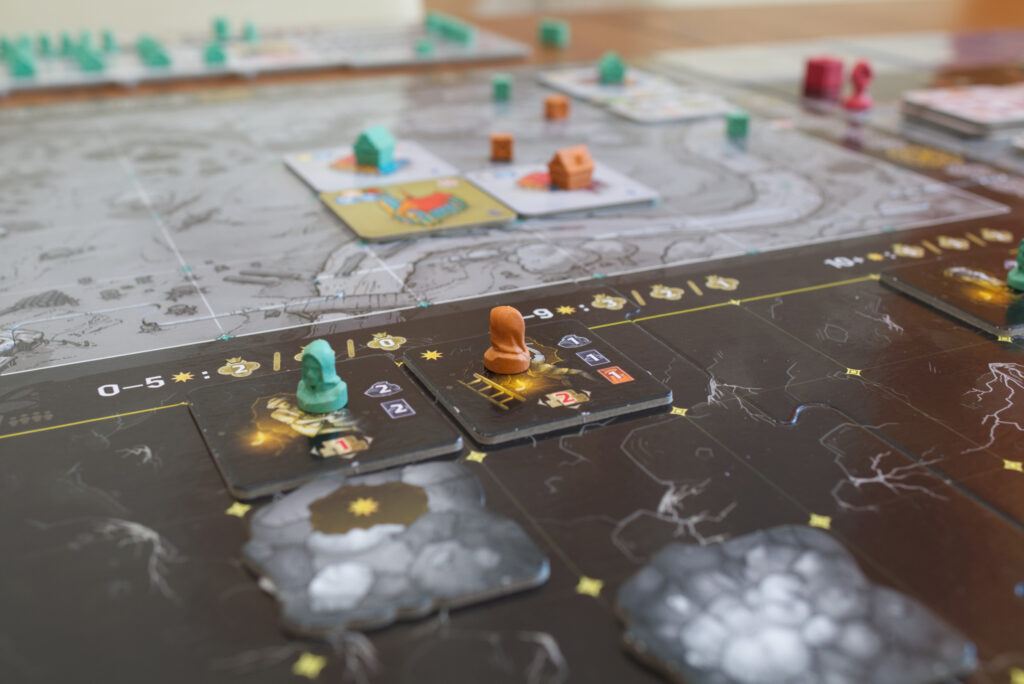
Very pleasant game, we all liked it a lot. At first, it was kind of tricky to get into. The rules are very well written and quite straight forward, but we all were initially unsure what to do and which strategy to follow. At the end of the game, we all had “a ha” moments and the next play will definitely be more spicy! Production is very well done (some shiny stuff and the re-wood alternative to plastic works well, the minis have nice level of detail) but it was surprising to me that there is no indication on the “computers” how many more increases in population or mines are needed before the next price change. I’m interested to see how things will develop on further plays. One thing that is particular is that each player is limited to being able to build three types of buildings. So even in a 4p game, there is only one other player that might be competition for you for a certain type of production and if they don’t act, a single player can get high prices uncontested.
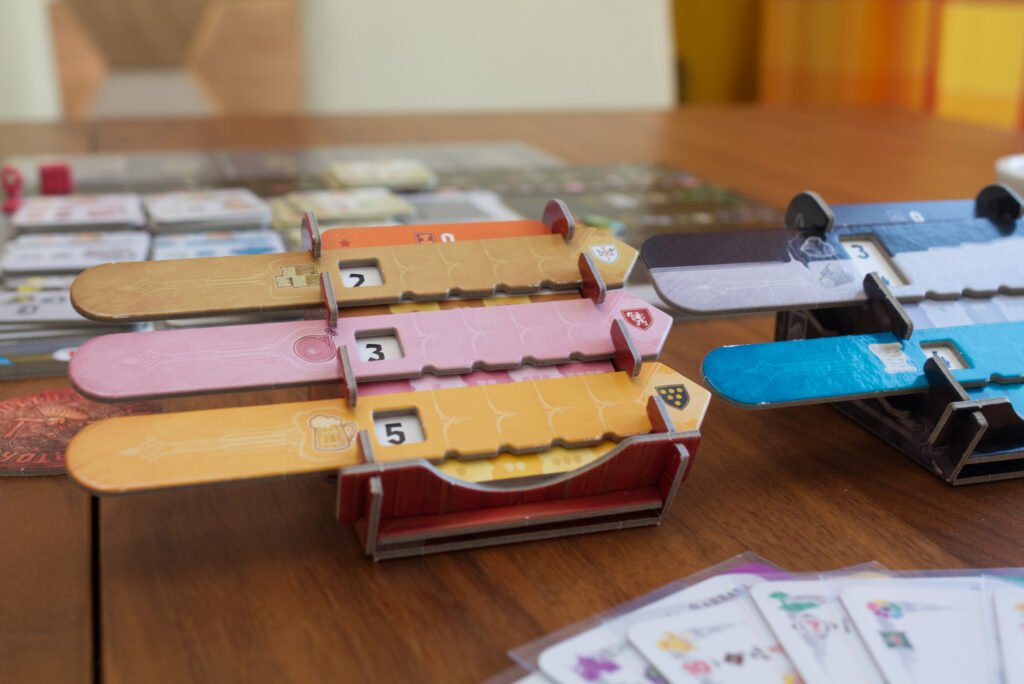
My current assumption is that Kutná Hora is a very good, solid game that a lot of people will enjoy. But it likely won’t be a must have of the year (though it’s really too soon to say after only one play). It doesn’t seem to have the thematic charm of Barcelona or the mechanical perfection and cohesion of a Tiletum. The biggest ding for me is that it unfortunately doesn’t have a solo mode. That said, I’d play it any time and look forward to more plays of it. Side note: the optional metal coins are very nicely done, really happy to have purchased them. There are no 10er though which is a shame. Otherwise they would make nice universal coins to use with other games as well.
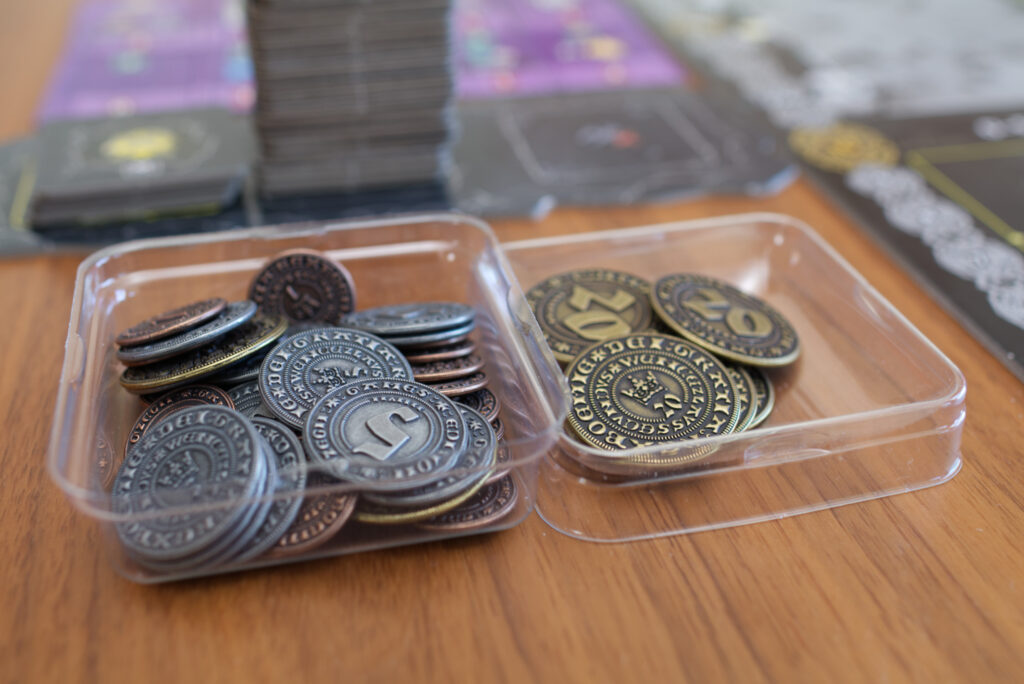
That wraps up a rather relaxed day three for me. Tomorrow I plan to tackle Evacuation, something I look forward to a lot! For those that have been at Essen on Saturday, please post in the comments what it was like for you! How big were the crowds? Did you manage to get seats at games you wanted to try? What was your highlight so far?
And here is the short interview I did on Thursday with Vangelis Bagiartakis (of Hegemony: Lead Your Class to Victory fame) about their upcoming game World Order as well as the image I promised of the excellent Hegemony card dividers you can buy at the Hegemonic Project Games booth. Enjoy!
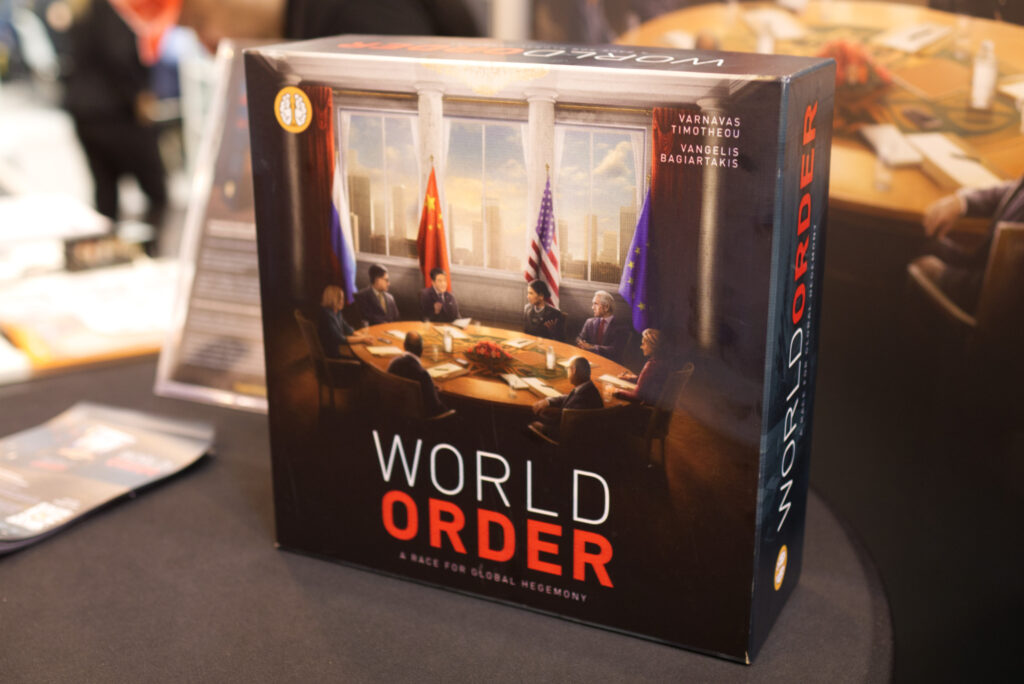
Tell me about World Order. What can people look forward to and how is it different or similar to Hegemony?
So World Order is our next game and we are announcing it here at the fair. We plan to do a Kickstarter for it at the beginning of 2024 and then release it towards the end of 2024 or early 2025. This is a game about international relations. The players take the roles of superpowers – lets say United States, China, Russia, or the European Union – and they try to spread their influence around the world. They do this in various ways like through diplomatic means, through economic means like with foreign investments or trade, and they also do it with military obviously.
Everybody is trying to increase their own influence in various regions around the world and at the same time they have to manage their – lets say – domestic options. It also matters in regards to what they can do in the foreign relations like for example Russia produces a lot of energy and has a lot of raw materials, China is very good at manufacturing consumable goods, European Union is a little bit better in diplomatic relations. So the players have some strengths and weaknesses which they take advantage of to further their own agendas.
As a game, it’s based on the same values as Hegemony. We want this game to be educational as well to allow you to learn a few things on how international relations work but in a fun way with engaging gameplay. It has some similarities [to Hegemony] in this aspect of the way that you play. It’s very thematic whatever you do, it’s very much tide to its theme. You feel like you are indeed one of those roles and do what they would do. But at the same time it’s not as heavy as Hegemony, it’s a bit lighter and it’s also a bit shorter in length. We thing whoever liked Hegemony is also going to love World Order.
I was wondering about the playtime because I just played Mr. President from GMT Games and it takes like two hours to set up, easily 8-10 hours to play one game. So what will world order be like?
[laughs] At the moment we are aiming at two hours for a full game. This is the goal, I don’t know if we will achieve it [smiles] but this is what we are trying to get. If we manage to have four players in two hours, we would be very happy.
Sounds very ambitious as a design goal! How asymmetric will it be? Will it be again that each player has different rules?
It’s not as asymmetric as Hegemony. In this game, you have different player boards, like you have different production capabilities, different setup, and slightly different cards in your starting deck but other than that the rules are the same for all players. So there is some asymmetry but not as much as in Hegemony where everybody did their own thing. Here you have the same rules but each player has strengths and weaknesses. So you have asymmetry in that way. You have things where you are better at. For example, the US are better at military presence compared to lets say the European Union or China.
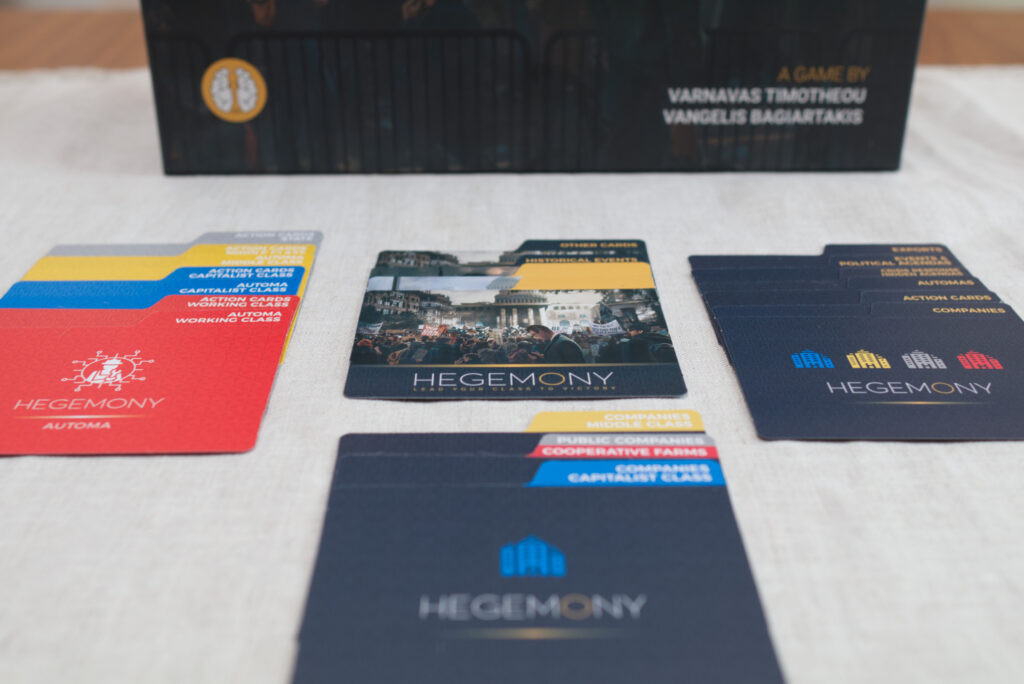
Is there a particular lesson you want to teach people? In Mr. President, it’s all about needing allies and you not being able to do stuff just on your own. But it has a very American world view. You’re the President of America, Russia and China are by definition adversaries in that game. How is it in World Order? Is it more that everyone has the same right to be there and the same positive and negative aspects?
Yes, we don’t want to take sides. We don’t want to paint someone as the good guy and the other as the bad guy. We are looking at it from an academic perspective. So we treat them equally in a sense. We already had some debate regarding the European Union because it’s different from the other three players. One can understand Russia, China, and the US as obviously being superpowers. The European Union is a bit more complicated [smiles] because it’s not a single country, it has different goals to the other ones. There was some debate on whether to include it as that. But in terms of the presence of countries in the world, the European Union has a similar role so it made sense to have it as a fourth player.
One thing I didn’t mention is that the game starts in 2010, so it also showcases some of the real life events that took place and players interact with them. There are crisis coming up in the game, like real crises that happened in the last decade, and players can chose to interfere or ignore them and let things play out as they did in real life. Or they can resolve some crisis through diplomatic means and prevent wars. You have that option here.
What’s the winning condition? Is it like the country that has the most influence or the most money?
There is an area control mechanism and there are regions on the board. You have your influence in the form of cubes – as I said through different means, either economically, militarily, or diplomatically – and you get majority. Based on majorities you get points and we look at those points at the end of the game. So it’s kind of straight forward. We didn’t want something too weird. There are some games where you have win conditions that happen suddenly and the other players – especially if they are new to the game – may not see it coming. So we went with straight forward victory points.
Sounds very, very interesting. The fair is one hour old, I’ve got new games in my bag and now all I’m thinking is I want to order this game, I want to play it now! [laughs]
Thank you!
Will you also do a nice booklet as you did for Hegemony?
This game is also based on the values we have as a company. We want to be educational so our games have a big educational value. We [collaborate] with academics to create another booklet with all the things that will be in the game and you will be able to read about them and learn things directly from academics from famous institutions around the world.
Sounds great. It was the first extra booklet in a game that I really enjoyed reading. I was like “oh, this is why this is happening!”. So I’m very much looking forward to your take on world politics.
After my conversation with Vangelis, I also talked to Nikolas who’s the Head of Marketing & Communication for Hegemonic Project. Unfortunately, I didn’t record that part of the conversation but it was fascinating to hear how Hegemony is used as a teaching tool in universities around the world and he also affirmed how much this educational approach to politics is very important to them as a company.
